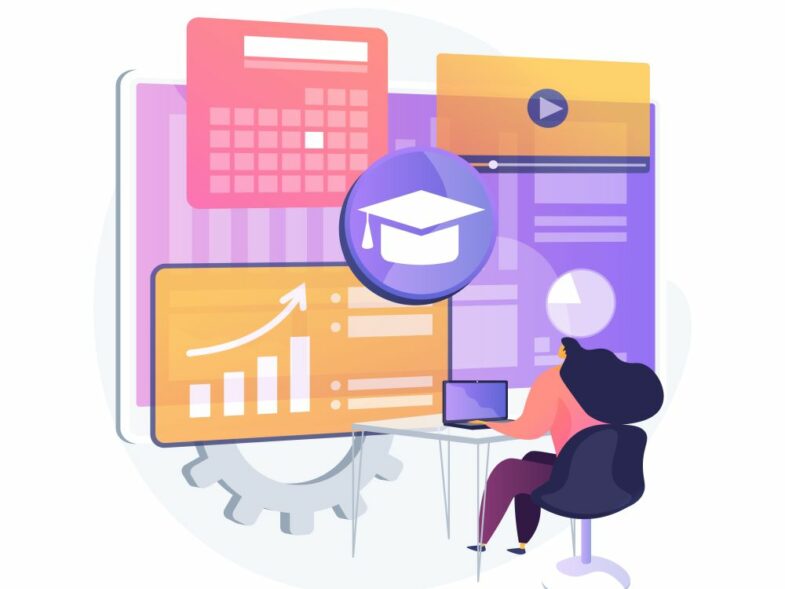Consider the problems that arise when it is necessary to manage training programs or educational courses. In your opinion, how can you guarantee that every participant receives what he or she wants without complicating the process? This is where an LMS (Learning Management System) comes in handy. It is aimed at content management, progress tracing, and learning process enhancement. However, even with these features, an LMS can sometimes appear as if it is not directly related to the people who are using it.
Well, suppose you take the learning structure of an LMS and marry it with the data processing might of a CRM. This integration is not about combining two tools – it is about reinventing how learning and management are combined. For organizations in the US and EU, using the services of an experienced LMS development company in US & EU guarantees the development of better-integrated solutions that are more effective for learners and administrators.
What Is an LMS and How Does It Work?
A Learning Management System is an application that is designed to deliver, monitor, and facilitate learning initiatives. In essence, an LMS is a hub for all educational material, whether you are a teacher training students or an employer training employees. Students are able to enroll for courses, submit assignments, and monitor their progress all from one platform.
Key Features of an LMS
The key to the success of an LMS is its features. Tools commonly found in systems are content uploaders, assignment generators, and performance evaluators. These features make it possible to have standard and stable performance in both corporate and educational environments. Contemporary LMS solutions also allow third-party applications, like video conferencing software, for distance education. Features such as the gamification modules and the learning paths are now vital for the users. Businesses in the US and EU today focus on the systems that enable integrated solutions, which make the LMS flexible to fit the company’s process.
Unique Needs in LMS Development
When you are in the process of designing or choosing an LMS, you should take into consideration the LMS development company. Companies in the US and EU need more customized products that correspond to their fields or legal frameworks, like GDPR in Europe. This customization helps in making sure that systems fit both operational and cultural requirements hence making the implementation process easier.
What Does a CRM Bring to the Table?
CRM system is intended to handle interactions and enhance relations. Originally, CRM systems were applied only to sales, but nowadays, they play an important role in education and training. Due to the fact that CRMs sort users’ data, it provides a complete vision of their preferences, activity, and correspondence history, which makes them helpful for LMS incorporation.
Supporting Learning with CRM Features
CRMs are best suited for handling user-related information like learner interactions and their level of engagement. For instance, a CRM can identify which courses have high dropout rates and suggest changes to the LMS curriculum. This insight not only makes learning more individual but also assists the administrators in enhancing the effectiveness of the system.
Strategic Use in US & EU Markets
In areas such as the US and EU, where companies have branches, CRMs assist in maintaining order and compliance across all branches. With the integration of CRMs, organizations can get a holistic view of training outcomes when used in conjunction with an LMS to meet market needs as they evolve. Some of the LMS development companies in these regions often recommend CRM integration as a standard feature for clients wanting to gain a competitive advantage.
Why Integrate LMS with CRM?
Personalization for Better Learning
Integration means that learning can be individualized. For instance, if a CRM shows that an employee is interested in leadership training, then the LMS will suggest the right classes. This match between individual needs and resources is particularly important for MNEs in the US and EU, where the employees are diverse.
Centralized Data for Efficiency
It also helps avoid the use of many systems to collect training and performance data. An important feature of the system is that all learners’ information, feedback, and performance indicators are presented in the central control panel. The above approach is especially helpful for enterprises that have to deal with multiple teams or branches.
Scalability for Growing Organizations
For companies that are planning expansion in the US and EU, integration allows LMS systems to grow with the company. When using an LMS development company, businesses can have more adaptive systems for new users, languages, or compliance that are added as the business grows.
Enhanced Decision-Making
The integration of LMS and CRM systems yields more detailed analysis of the return on investment for training. For instance, organizations can determine how certain courses impact the staff’s performance or customers’ satisfaction rate so that it becomes easy to plan for the following periods.
Steps to Successfully Integrate CRM with an LMS
Define Clear Goals
Start by identifying what you want to achieve with the integration:
- Get more students to finish their courses, spend less money on training, or engage employees.
- Concentration should be made on the basic applications, such as reporting applications, analytic systems, or tailored mastering options.
- Engage managers and team leaders to ensure that the objectives are in line with the organization’s goals and objectives.
Plan and Execute the Integration
Develop a clear plan with your IT and training teams:
- Select an LMS with support for API or an LMS that has pre-integrated with the CRM.
- Organize a pilot program where you can discover the difficulties that may appear and repair or optimize the system.
- Make sure all users are aware of the integrated system and the potential of the system they are using.
Long-Term Success with LMS and CRM Integration
Integrating an LMS with a CRM goes beyond the simple technical exercise; it is an organizational investment. The US and EU remain the leading markets for the demand for scalable and efficient training systems, so businesses have to reassess their solutions periodically. This means updating features, getting feedback, and being aware of technological developments.
That is why, with proper systems implemented, organizations can leverage new tools such as predictive analytics and AI recommendations. These technologies improve the training process and increase its effectiveness. Therefore, working with an LMS development company will help businesses maintain the flexibility of their systems and their ability to meet their future objectives.









